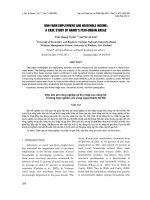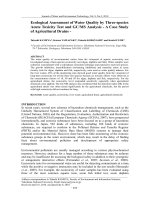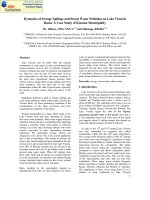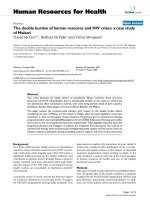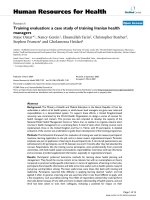Response to oil price change: A case study of national oil companies in southeast ASIA
Bạn đang xem bản rút gọn của tài liệu. Xem và tải ngay bản đầy đủ của tài liệu tại đây (771.45 KB, 9 trang )
������������������������������������������������������������������������������������������������������������������������������������������������������������������������������������������������������������������������������������������������������������������������������������������������������������������������������������������������������������������������������������������������������������������������������������������������������������������������������������������������������������������������������������������������������������������������������������������������������������������������������������������������������������������������������������������������������������������������������������������������������������������������������������������������������������������������������������������������������������������������������������������������������������������������������������������������������������������������������������������������������������������������������������������������������������������������������������������������������������������������������������������������������������������������������������������������������������������������������������������������������������������������������������������������������������������������������������������������������������������������������������������������������������������������������������������������������������������������������������������������������������������������������������������������������������������������������������������������������������������������������������������������������������������������������������������������������������������������������������������������������������������������������������������������������������������������������������������������������������������������������������������������������������������������������������������������������������������������������������������������������������������������������������������������������������������������������������������������������������������������������������������������������������������������������������������������������������������������������������������������������������������������������������������������������������������������������������������������������������������������������������������������������������������������������������������������������������������������������������������������������������������������������������������������������������������������������������������������������������������������������������������������������������������������������������������������������������������������������������������������������������������������������������������������������������������������������������������������������������������������������������������������������������������������������������������������������������������������������������������������������������������������������������������������������������������������������������������������������������������������������������������������������������������������������������������������������������������������������������������������������������������������������������������������������������������������������������������������������������������������������������������������������������������������������������������������������������������������������������������������������������������������������������������������������������������������������������������������������������������������������������������������������������������������������������������������������������������������������������������������������������������������������������������������������������������������������������������������������������������������������������������������������������������������������������������������������������������������������������������������������������������������������������������������������������������������������������������������������������������������������������������������������������������������������������������������������������������������������������������������������������������������������������������������������������������������������������������������������������������������������������������������������������������������������������������������������������������������������������������������������������������������������������������������������������������������������������������������������������������������������������������������������������������������������������������������������������������������������������������������������������������������������������������������������������������������������������������������������������������������������������������������������������������������������������������������������������������������������������������������������������������������������������������������������������������������������������������������������������������������������������������������������������������������������������������������������������������������������������������������������������������������������������������������������������������������������������������������������������������������������������������������������������������������������������������������������������������������������������������������������������������������������������������������������������������������������������������������������������������������������������������������������������������������������������������������������������������������������������������������������������������������������������������������������������������������������������������������������������������������������������������������������������������������������������������������������������������������������������������������������������������������������������������������������������������������������������������������������������������������������������������������������������������������������������������������������������������������������������������������������������������������������������������������������������������������������������������������������������������������������������������������������������������������������������������������������������������������������������������������������������������������������������������������������������������������������������������������������������������������������������������������������������������������������������������������������������������������������������������������������������������������������������������������������������������������������������������������������������������������������������������������������������������������������������������������������������������������������������������������������������������������������������������������������������������������������������������������������������������������������������������������������������������������������������������������������������������������������������������������������������������������������������������������������������������������������������������������������������������������������������������������������������������������������������������������������������������������������������������������������������������������������������������������������������������������������������������������������������������������������������������������������������������������������������������������������������������������������������������������������������������������������������������������������������������������������������������������������������������������������������������������������������������������������������������������������������������������������������������������������������������������������������������������������������������������������������������������������������������������������������������������������������������������������������������������������������������������������������������������������������������������������������������������������������������������������������������������������������������������������������������������������������������������������������������������������������������������������������������������������������������������������������������������������������������������������������������������������������������������������������������������������������������������������������������������������������������������������������������������������������������������������������������������������������������������������������������������������������������������������������������������������������������������������������������������������������������������������������������������������������������������������������������������������������������������������������������������������������������������������������������������������������������������������������������������������������������������������������������������������������������������������������������������������������������������������������������������������������������������������������������������������������������������������������������������������������������������������������������������������������������������������������������������������������������������������������������������������������������������������������������������������������������������������������������������������������������������������������������������������������������������������������������������������������������������������������������������������������������������������������������������������������������������������������������������������������������������������������������������������������������������������������������������������������������������������������������������������������������������������������������������������������������������������������������������������������������������������������������������������������������������������������������������������������������������������������������������������������������������������������������������������������������������������������������������������������������������������������������������������������������������������������������������������������������������������������������������������������������������������������������������������������������������������������������������������������������������������������������������������������������������������������������������������������������������������������������������������������������������������������������������������������������������������������������������������������������������������������������������������������������������������������������������������������������������������������������������������������������������������������������������������������������������������������������������������������������������������������������������������������������������������������������������������������������������������������������������������������������������������������������������������������������������������������������������������������������������������������������������������������������������������������������������������������������������������������������������������������������������������������������������������������������������������������������������������������������������������������������������������������������������������������������������������������������������������������������������������������������������������������������������������������������������������������������������������������������������������������������������������������������������������������������������������������������������������������������������������������������������������������������������������������������������������������������������������������������������������������������������������������������������������������������������������������������������������������������������������������������������������������������������������������������������������������������������������������������������������������������������������������������������������������������������������������������������������������������������������������������������������������������������������������������������������������������������������������������������������������������������������������������������������������������������������������������������������������������������������������������������������������������������������������������������������������������������������������������������������������������������������������������������������������������������������������������������������������������������������������������������������������������������������������������������������������������������������������������������������������������������������������������������������������������������������������������������������������������������������������������������������������������������������������������������������������������������������������������������������������������������������������������������������������������������������������������������������������������������������������������������������������������������������������������������������������������������������������������������������������������������������������������������������������������������������������������������������������������������������������������������������������������������������������������������������������������������������������������������������������������������������������������������������������������������������������������������������������������������������������������������������������������������������������������������������������������������������������������������������������������������������������������������������������������������������������������������������������������������������������������������������������������������������������������������������������������������������������������������������������������������������������������������������������������������������������������������������������������������������������������������������������������������������������������������������������������������������������������������������������������������������������������������������������������������������������������������������������������������������������������������������������������������������������������������������������������������������������������������������������������������������������������������������������������������������������������������������������������������������������������������������������������������������������������������������������������������������������������������������������������������������������������������������������������������������������������������������������������������������������������������������������������������������������������������������������������������������������������������������������������������������������������������������������������������������������������������������������������������������������������������������������������������������������������������������������������������������������������������������������������������������������������������������������������������������������������������������������������������������������������������������������������������������������������������������������������������������������������������������������������������������������������������������������������������������������������������������������������������������������������������������������������������������������������������������������������������������������������������������������������������������������������������������������������������������������������������������������������������������������������������������������������������������������������������������������������������������������������������������������������������������������������������������������������������������������������������������������������������������������������������������������������������������������������������������������������������������������������������������������������������������������������������������������������������������������������������������������������������������������������������������������������������������������������������������������������������������������������������������������������������������������������������������������������������������������������������������������������������������������������������������������������������������������������������������������������������������������������������������������������������������������������������������������������������������������������������������������������������������������������������������������������������������������������������������������������������������������������������������������������������������������������������������������������������������������������������������������������������������������������������������������������������������������������������������������������������������������������������������������������������������������������������������������������������������������������������������������������������������������������������������������������������������������������������������������������������������������������������������������������������������������������������������������������������������������������������������������������������������������������������������������������������������������������������������������������������������������������������������������������������������������������������������������������������������������������������������������������������������������������������������������������������������������������������������������������������������������������������������������������������������������������������������������������������������������������������������������������������������������������������������������������������������������������������������������������������������������������������������������������������������������������������������������������������������������������������������������������������������������������������������������������������������������������������������������������������������������������������������������������������������������������������������������������������������������������������������������������������������������������������������������������������������������������������������������������������������������������������������������������������������������������������������������������������������������������������������������������������������������������������������������������������������������������������������������������������������������������������������������������������������������������������������������������������������������������������������������������������������������������������������������������������������������������������������������������������������������������������������������������������������������������������������������������������������������������������������������������������������������������������������������������������������������������������������������������������������������������������������������������������������������������������������������������������������������������������������������������������������������������������������������������������������������������������������������������������������������������������������������������������������������������������������������������������������������������������������������������������������������������������������������������������������������������������������������������������������������������������������������������������������������������������������������������������������������������������������������������������������������������������������������������������������������������������������������������������������������������������������������������������������������������������������������������������������������������������������������������������������������������������������������������������������������������������������������������������������������������������������������������������������������������������������������������������������������������������������������������������������������������������������������������������������������������������������������������������������������������������������������������������������������������������������������������������������������������������������������������������������������������������������������������������������������������������������������������������������������������������������������������������������������������������������������������������������������������������������������������������������������������������������������������������������������������������������������������������������������������������������������������������������������������������������������������������������������������������������������������������������������������������������������������������������������������������������������������������������������������������������������������������������������������������������������������������������������������������������������������������������������������������������������������������������������������������������������������������������������������������������������������������������������������������������������������������������������������������������������������������������������������������������������������������������������������������������������������������������������������������������������������������������������������������������������������������������������������������������������������������������������������������������������������������������������������������������������������������������������������������������������������������������������������������������������������������������������������������������������������������������������������������������������������������������������������������������������������������������������������������������������������������������������������������������������������������������������������������������������������������������������������������������������������������������������������������������������������������������������������������������������������������������������������������������������������������������������������������������������������������������������������������������������������������������������������������������������������������������������������������������������������������������������������������������������������������������������������������������������������������������������������������������������������������������������������������������������������������������������������������������������������������������������������������������������������������������������������������������������������������������������������������������������������������������������������������������������������������������������������������������������������������������������������������������������������������������������������������������������������������������������������������������������������������������������������������������������������������������������������������������������������������������������������������������������������������������������������������������������������������������������������������������������������������������������������������������������������������������������������������������������������������������������������������������������������������������������������������������������������������������������������������������������������������������������������������������������������������������������������������������������������������������������������������������������������������������������������������������������������������������������������������������������������������������������������������������������������������������������������������������������������������������������������������������������������������������������������������������������������������������������������������������������������������������������������������������������������������������������������������������������������������������������������������������������������������������������������������������������������������������������������������������������������������������������������������������������������������������������������������������������������������������������������������������������������������������������������������������������������������ion [11].
Pertamina’s material number, through material code
standardisation from Pertamina nomenclature into
global Shell code nomenclature.
Governance:
risk policy,
organisation
& structure, role &
responsibilities
Continual
improvement
system
monitoring &
review, risk
assurance,
capacity
building
Context
setting:
external/
internal, risk
appetite/
criteria
Risk
monitoring &
review: reporting &
monitoring,
information
system
Risk
assessment:
identification,
analysis,
evaluation
Risk
treatment:
strategy, plan
Figure 5. Enterprise risk management framework.
- Digital marketing: implementation of B2B and B2C
technology/application; acceleration of culture change in
relation to creativity and promoting an agile work scheme.
- PTKAM ICT improvement was conducted through the
ERP and non-ERP (web E-LC) enhancement system, supporting
loss calculations that occurred as a result of oil flow activities.
- Logistic excellence was an ongoing improvement of
60
PETROVIETNAM - JOURNAL VOL 6/2020
- Corporate
administration
system
reengineering encompassed the development of
E-Correspondence 2.0 using an alternative platform
to the previous version, from the web 1.0 to the web
3.0.
- Concurrent employment and corporation
management was an expansion of the SAP HCM
Module, used for multiple employment scenario
management between the company and its
subsidiaries.
- Investment improvement programme aimed
to monitor the success of Investment Projects. In
2017, Pertamina implemented Direct Link SIIP at
2 of its subsidiaries: PT. Pertamina EP Cepu and PT.
PDSI and the non-business development marketing
directorate (527 projects).
In this challenging time, technology has proved
its crucial role in cost reduction, efficient operation
and driving higher competence for oil and gas companies.
4.2.2. Risk management is essential in strengthening
abilities to withstand forthcoming uncertainties
Throughout years of development, the Board
Governance & Risk Committee has been established
in Petronas to provide oversight and in-depth discus-
PETROVIETNAM
Governance:
Risk struture,
oversight/CM
three-tiered response
protocol, activation,
role &
responsibilities
Continual
improvement:
as in ERM
framework
Strategi
c risks
Crisis
assessment: risk
assessment,
credible
scenarios
identification,
thresholds
identification
Crisis response
strategy: strategies,
actions development,
resources identification,
emergency/CM plan
establishment/
communication
Testing &
exercising:
Planning,
excecution&
review
- Risks from business strategy implementation;
- Risk from diminishing natural gas outputs,
continuity of gas production;
- Risks concerning investment efficiency;
- Risks concerning personnel development to
accommodate business growth;
- Reputation risks.
Business
risks
- Price volatility of petroleum and petrochemicals;
- Government actions creating potential impacts
on PTT businesses.
Operatio
n risks
- Disruption of production, business operations;
- Changes in environmental, safety regulations;
- Delayed project construction.
Financial
risks
- The volatility of Baht
- Financial support to affiliated companies;
- Acquisition of funds for plan execution.
Figure 8. PTT key risk factors [5].
Figure 6. Crisis management framework.
Governance:
as in ERM
framework
Figure 9. Pertamina ERM roadmap [6].
Continual
improvement
as in ERM
framework
Risk
assessment
as in ERM
framework
Testing &
exercising:
plan, BCP
simulation
Business
impact analysis:
critical business
functions,
minimum
resource
requirement
Business
recovery strategy:
recovery strategy,
business
continuity
plan
Figure 7. Business continuity management framework.
sion on risk management at the Board level. Since 2015,
the Resiliency Model has focused on 3 areas, namely Enterprise Risk Management (ERM) - Figure 5, Crisis Management (CM) - Figure 6 and Business Continuity Management (BCM) - Figure 7 [3].
A Risk Management Committee was appointed to steer
all risk management activities in PTT: monitoring risk management every quarter, deliberating and commenting on
long-term obligations, business complication, significant
impacts toward the corporate, screening the list of corporate risks and seeking endorsement of the Board. Emerging risk factors had been identified and managed annually under risk management plans. PTT continues to refine
the risk factors to better reflect risks affecting investors
(Figure 8).
ISO 31000: 2009, a global risk management standard,
has been put into implementation in Pertamina since 2011.
The roadmap implementation was done in stages,
starting from risk awareness, framework, discipline to
habit and culture (Figure 9). Throughout 2017, 1,908 risks
with 1,071 qualitative risks and 837 quantitative risks
were found. From the identification result, the risk profile
(financial risk4, operational and infrastructure risk5, risk of
governance6, compliance risk7, reporting risk8) was obtained by the Board of Directors and the mitigation plans
were undertaken.
Financial risk is associated with accounting, credit, liquidity & financial intelligence, financial market, planning & budgeting, and operational, which has resulted in financial loss, including the risk of movement
or fluctuation of market variables: commodity prices, interest rates, oil prices and the risk of delays or failures of customers.
5
Operational & infrastructure risk contains corporate assets, human resources, information technology, external events, legal, process management, product development, sales, marketing and communications.
6
Risk of Governance is caused by the lack of or non-compliance with the rules of Corporate Governance and Business Ethics.
7
Compliance risk is derived by the deficiency of or non-compliance with prevailing regulations. There are two major risks: the Risk of a Decreasing Good Corporate Governance Assessment and Fraud Risk.
8
Reporting risk is related to the obligation to submit reports to interested parties/shareholders.
4
PETROVIETNAM - JOURNAL VOL 6/2020
61
PETROLEUM ECONOMICS & MANAGEMENT
In short, the oil price shock, a frequent issue in short/
middle-terms which happened in many years, is regarded
as one of the most crucial components in the overall risk
profile. Thanks to effective risk management frameworks
connecting at all levels in each NOC, the decision makers
have been efficiently assisted to achieve the company’s strategic objectives in a fair, informed, and transparent manner.
5. Conclusion
Although the upstream recorded low profit in the first
year of the period 2015 - 2017 because of oil price downturn, in the following years it recovered steadily thanks to
significant efforts to improve operational efficiency and
cost management. In the downstream, revenue was exceptional due to lower oil price, higher production and sales,
less impairment from a lower inventory as well as increasing refinery capacity. In general, the NOCs' performance
was sustained thanks to their complete business value
chains with a consolidated interrelation among sectors,
which helped to offset the loss of one business segment by
the earnings of others.
These best practices in Petronas, PTT and Pertamina
give some reflections to PVN. The overall success of remaining highly resilient firstly comes from considering
low oil price as the most-likely scenario in order to regularly develop and revise short-term and middle-term business plans and long-term strategies to accommodate future changes. Secondly, it is the company’s preparedness
and readiness to adapt that enable necessary actions
to be implemented in time. Each NOC might pursue different paths to respond to particular contexts; however,
the fundamental issues are (i) (at the capability level) the
establishment of consistent policies and guidelines that
guarantees the risk management system enforcement; (ii)
(at the portfolio level) portfolio refining toward competitive advantages; and (iii) (at the operational level) extending cost reduction into strategic productivity improvements and utilising technology in all lines of businesses.
References
[1] Forbes, “GLOBAL 2000: The world's largest public
companies”, 13/5/2000. [Online]. Available: https://www.
forbes.com/global2000/#780ebf52335d.
[2] Statista, “Average annual OPEC crude oil price
from 1960 to 2020”. [Online]. Available: https://www.
62
PETROVIETNAM - JOURNAL VOL 6/2020
statista.com/statistics/262858/change-in-opec-crude-oilprices-since-1960/.
[3] Adelaida Salikha, “Asia's Pacific largest oil & gas
companies in 2017”, 27/10/2018. [Online]. Available:
-largest-oil-gascompanies-in-2017-by-revenue.
[4] Silvana Tordo, Brandon S.Tracy, and Noora Arfaa,
“National oil companies and value creation, Volume II:
Case studies”, World Bank Working Papers, No. 218, 2011.
[Online]. Available: ldbank.
org/handle/10986/16651.
[5] Bianca Sarbu, Ownership and control of oil,
explaining policy choices across producing countries,
Routledge Taylor and Francis Group, 2014. DOI:
10.4324/9781315778099.
[6] Nick Lioudis, “What causes oil prices to fluctuate?”,
21/4/2020. [Online]. Available: estopedia.
com/ask/answers/012715/what-causes-oil-pricesfluctuate.asp.
[7] Ir.V.R.Harindran,
“Petronas
refinery
&
petrochemical complex - digital automation journey”,
Proceeding of the 1st ISA Event 2019, Ho Chi Minh,
Vietnam, 13 June, 2019.
[8] Petronas, “Annual reports”. [Online]. Available:
/>[9] Boston Consulting Group. [Online]. Available:
/>[10] BCG, "Resilience - A vital capability in today's
volatile environment", 2015.
[11] Pertamina, “Annual reports”. [Online]. Available:
/>[12] PTT, “Annual reports”. [Online]. Available: https://
www.pttplc.com/en/Media/Publications/Report.aspx.
[13] Rai Technology University, “Security analysis
and portfolio management”, [Online]. Available:
http://164.100.133.129:81/econtent/uploads/security_
analysis_&_portfolio_management.pdf.
